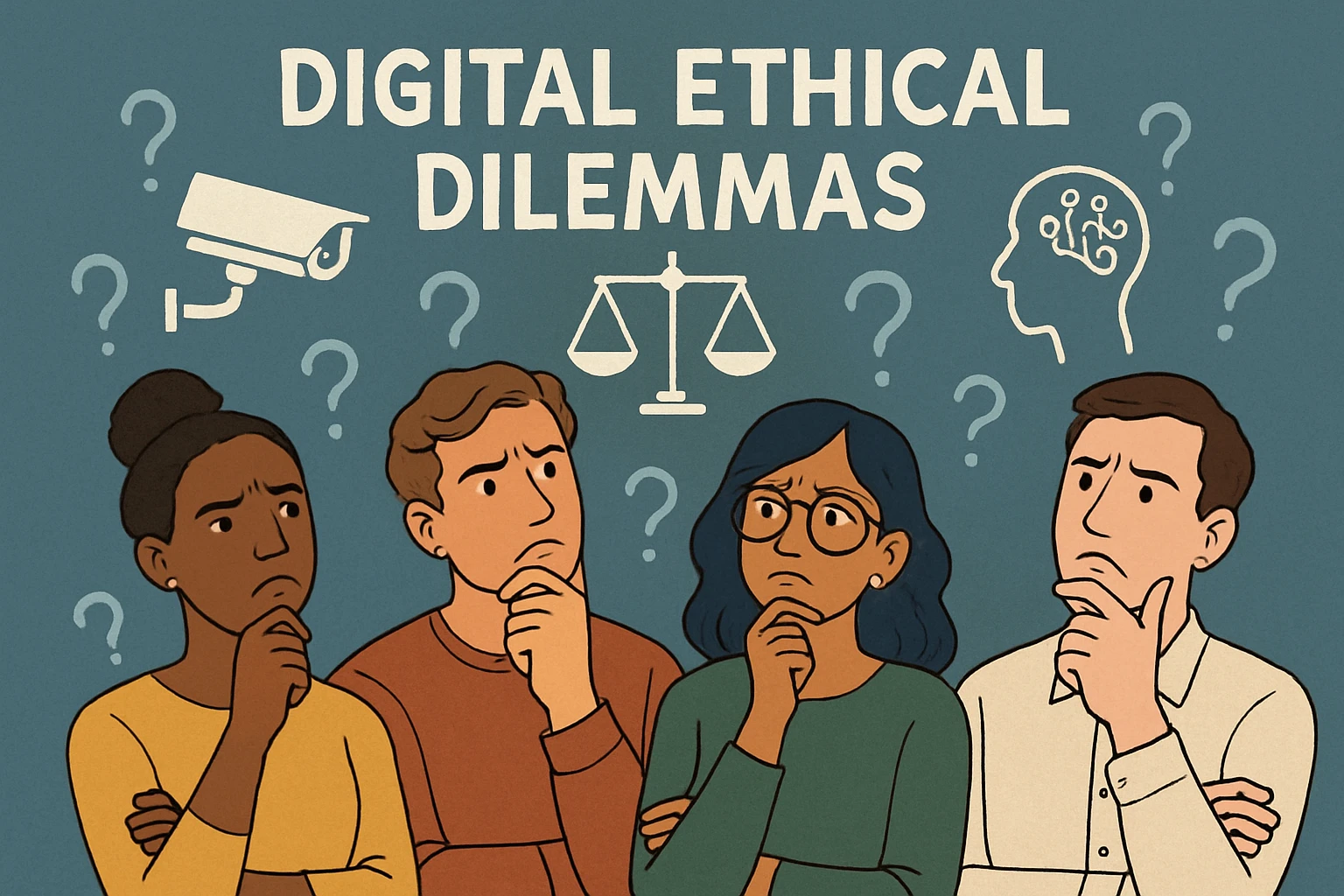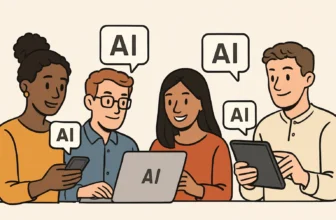
Are We Ready for AI’s Ethical Dilemmas?
Here’s a wild stat to wrap your head around: by some estimates, AI could be responsible for making up to 70% of business decisions in the near future. That means everything from who gets a loan to how a courtroom rules on a low-level offense could involve artificial intelligence. Sound exciting? Absolutely. Terrifying? Also yes.
Let’s be real—AI isn’t just spitting out Spotify playlists anymore. It’s diagnosing illnesses, screening job applicants, and even dabbling in art and literature. Basically, AI is moving out of the garage and into the boardroom (and the voting booth, and the hospital…). The tech is incredible, sure—but here’s the rub: what happens when those algorithms make questionable calls?
I remember sitting with a friend—an AI engineer, no less—who admitted, “Honestly, I don’t always know why the model made that choice.” That hit me like a brick. If the *developers* don’t fully understand the decisions AI is making, how are we supposed to trust them with, say, a parole recommendation?
So, What’s the Ethical Problem?
We’re at a moment where machines can “think” and make decisions faster than we ever dreamed. But with that power comes a baggage claim full of ethical challenges. Bias, accountability, transparency, privacy—sound familiar? These aren’t just abstract principles from your ethics 101 class. These are real-world issues affecting people’s lives *today.*
Imagine this: A health algorithm downgrades symptoms in minority patients, leading to under-treatment. It’s happened. Or a hiring tool filters out resumes based on zip codes, penalizing underprivileged communities. Also real. These systems were trained on data reflecting human bias—and surprise, they’ve gone ahead and supercharged it in code.
Okay, So How Do We Handle This?
It’s not all doom-and-glitch. There are some concrete ways we can gear up and do better:
- Build Ethics into Every Stage: From initial data selection to algorithm deployment, ethical checks should be baked in—not tacked on like an afterthought.
- Interdisciplinary Teams FTW: Pair your data scientists with sociologists, ethicists, and legal experts. Good AI isn’t just about precision—it’s about people.
- Push for Transparency: Demand explainable AI. If the system can’t explain its choices in a way a human can understand, it shouldn’t be making high-stakes decisions.
I’ve found the most valuable breakthroughs happen when technologists and ethicists stop speaking different languages and create space for meaningful collaboration. If you’re a techie, find time to consult with ethicists. If you’re an ethicist, don’t be afraid to roll up your sleeves and dive into the code (or at least the documentation).
Looking Forward with Hope (Yes, Really)
Here’s the good news: awareness around AI ethics is growing. Fast. Standards are being shaped globally, companies are hiring Chief Ethics Officers, and folks like *you* are diving deeper into what it all means. We’re building the future right now—bugs, biases, beauty and all. Let’s do it with eyes wide open and a moral compass that actually works.
So. Are we ready for AI’s ethical dilemmas? Maybe not fully. But with intention, collaboration, and a willingness to ask the hard questions, we’re definitely getting there.
Understanding AI’s Ethical Landscape
Did you know that an AI-powered hiring tool once favored male candidates simply because it “learned” from a dataset filled with past male hires? Yeah — right out of the gate, bias baked into algorithms. Wild, right? But also, kind of terrifying. And it’s just one tiny corner of a much bigger ethical puzzle we’re trying to solve with AI.
As AI slides into more corners of everyday life — from self-driving cars and court sentencing tools to healthcare diagnostics and facial recognition — the ethical questions keep multiplying like pop-ups you can’t close. It’s like, for every cool thing AI can do, there’s a thorny “Should it?” right behind it. And honestly, I get it. I’m just as excited about AI’s potential as you probably are. But let’s be real for a second: we can’t ignore the moral landmines, especially when people’s rights, safety, or even lives could be impacted.
So, what’s going on here?
The big problem? There isn’t just one ethical dilemma with AI. There are dozens — and they’re all shaped by the context the AI is working in. A self-driving car has to make literal life-and-death decisions in split seconds (shoutout to the classic trolley problem, modernized). Meanwhile, facial recognition used in public surveillance is raising serious consent and privacy issues — not to mention how frequently it misidentifies people of color.
No one-size-fits-all rulebook is going to cut it. What we’re really grappling with is a patchwork of rapidly evolving technologies outpacing our existing ethical frameworks. It’s messy. But it’s a mess worth cleaning up.
Here’s what we can actually *do* about it
- Push for strong, adaptable policy frameworks. AI isn’t static, and our policies shouldn’t be either. Support national and global bodies developing AI-specific regulations — like the EU’s AI Act. They’re not perfect (yet), but they’re powerful starting points.
- Get involved in interdisciplinary collaboration. Ethicists, technologists, policymakers — we all need to be at the table. Engineers can’t code morality into a system alone, and ethicists can’t evaluate impact without context. Team effort, folks.
- Stay informed and educate others. Whether it’s subscribing to newsletters like AlgorithmWatch or attending Zoom panels with AI and ethics experts, keep the learning loop going. Bring others into the convo — friends, co-workers, even your grandma. Seriously, everyone’s affected by this stuff.
Let’s shape the future — ethically
Here’s the thing: AI isn’t inherently good or bad. It’s a mirror — reflecting the values and decisions of those who design and deploy it. And you, reading this, have a say in what it reflects. We’re still early in the game, which means we’ve got time — and a chance — to establish the boundaries now so we’re not scrambling later.
So let’s be the generation that doesn’t just chase innovation but also asks the hard questions. Not to slow down progress, but to make sure everyone comes along for the ride — safely, fairly, and with dignity intact.
Bias and Fairness in AI Decisions
Did you know that an AI recruiting tool once taught itself to prefer male job applicants over female ones? Yep—real thing. Because it was trained on past hiring data from a male-dominated industry, the system basically said, “Oh, men keep getting hired? Cool, must mean they’re better.” Yikes, right?
If that makes you cringe, you’re not alone. Bias in AI isn’t just a “tech issue” stuck behind a server. It bleeds into real life—in how people get hired, sentenced, or even approved for loans. And the scariest part? Most of the time, no one notices the problem until it becomes public (read: public *and* messy).
So, what’s actually going on? AI systems learn from data. Period. But if that data reflects historical inequalities—say, biased policing, gender pay gaps, or racially skewed school testing—then guess what the AI ends up learning? The same old biases, just now with algorithmic confidence. It’s like putting a suit on a stereotype and calling it “data-driven.”
Let’s make it real: a couple of jaw-droppers
- Hiring algorithms: A famous case at a tech giant revealed their in-house AI tool penalized resumes if they included the word “women’s,” like in “women’s chess club” or “women’s college.”
- Predictive policing: In some U.S. cities, these systems were found to over-target predominantly Black neighborhoods, not because crime rates were higher, but because the data reflected decades of over-policing. It became a feedback loop of injustice.
I’ve seen firsthand how these biases sneak in during development. A team I once collaborated with almost released a chatbot that, while charmingly witty, kept reinforcing gender stereotypes in its responses. It was subtle—but persistent. We caught it during testing (thank goodness), but not everyone’s that lucky.
Okay, so how do we fight back?
Here’s the good news: bias isn’t a mystery—we know it’s there. That means we can do something about it. Start here:
- Audit your training data like it’s under a microscope. Ask who’s included, who’s missing, and what historical baggage that dataset might be dragging around. Bring in ethicists and domain experts, not just developers.
- Use bias-detection tools regularly—not just once. There are some solid open-source options out there, like IBM’s AI Fairness 360 or Google’s What-If Tool. Set them up early, and run them often. Trust me, late-stage fairness is a nightmare.
- Be radically transparent. Document how your models were trained, what data was used, and how decisions are made. Publish model cards and data sheets, and keep the door open for external review—especially from diverse voices. If you don’t know how it works, how do you expect a user to trust it?
Looking ahead: fairness isn’t a checkbox—it’s a mindset
Here’s the thing: AI doesn’t have to reflect the past. It can actually help us shape a better future—*if* we build it thoughtfully. And that starts with seeing fairness as something ongoing, not a one-time fix. We’ve all inherited systems full of invisible biases… but AI lets us question those systems, challenge them, and maybe even reimagine them.
So, let’s not just automate the world—we can rebuild it, one fair, transparent model at a time.
Privacy Concerns in AI Innovations
Here’s a wild stat for you: it’s estimated that over 90% of all data in the world was generated in just the last few years. Sounds bananas, right? Now imagine what AI can do with that mountain of personal information. Wonderful things, sure—but also, let’s be real—slightly terrifying things.
I mean, we’ve all been there… talking about a holiday with a friend, and two minutes later your phone shows you ads for hotels in Bali. Coincidence? Probably not. That’s AI working hand-in-hand with data collection, and it’s precisely where privacy alarms start ringing.
The Problem: When AI Knows a *Little* Too Much
AI systems thrive on data—lots of it. The more personal, the better (from the machine’s point of view). But here’s the kicker: the lines between smart technology and surveillance are blurring fast. Think facial recognition in public spaces or predictive algorithms determining your creditworthiness based on obscure behavior patterns. It’s not science fiction anymore—it’s real life, and it’s happening now.
There’s a very thin line between personalized convenience and invasive oversight. And while companies will often claim data anonymity, breaches and misuse happen more often than any of us would like to admit. I once worked on a project where anonymized data ended up being very traceable back to individuals—just based on location and time stamps. That was a wake-up call.
The Solution: Ethics Meets Enforcement
So, how do we protect people’s privacy without grinding innovation to a halt? It starts with two key areas: stronger data protection laws and ethically designed AI systems.
- Beef up data laws. GDPR was a great start, but it can’t be the finish line. AI introduces new complexities—like inferential analytics—that older privacy frameworks don’t fully address. We need regulations that evolve with tech, not lag 10 years behind.
- Design for ethical guardrails. That means baking consent, transparency, and fairness into AI systems from day one. Not as a compliance checkbox, but as a core principle. Think: explainable algorithms and clear opt-in choices for users.
- Use ethical review boards. Yep, just like medical studies. Committees of ethicists, technologists, and citizen reps should be involved in evaluating big-impact AI deployments—especially in high-risk sectors like law enforcement or healthcare.
Real-World Wake-Up Call: Surveillance Systems
Let’s talk about surveillance AI. It’s a hotbed for privacy infractions. There are cities using AI-powered CCTV that not only tracks faces in a crowd but recognizes emotions, predicts intent, and flags “unusual behavior.” Sounds helpful on the surface… until you realize it’s often done without consent and disproportionately affects vulnerable communities. Scary stuff.
And once data is collected—whether it’s your face, your walking pattern, or your shopping habits—it can be stored indefinitely, sold, or repurposed without you ever knowing.
What Can You Do About It?
Here’s where we, as technologists and ethicists, roll up our sleeves:
- Push for verified user consent. Systems should explicitly ask and clearly explain what data they’re collecting and why. No more hiding behind vague “terms of service.”
- Champion privacy-first development. Whether you’re coding algorithms or advising policy, advocate for privacy by design. Build it in—not bolt it on.
- Educate users and policymakers alike. Bridge the knowledge gap. Many people don’t realize how much data they’re handing over—until it’s too late. Spread awareness and encourage smart data hygiene.
Let’s Build a Future That Respects Privacy
Here’s the thing—AI can be amazing. It can make our lives easier, safer, even more inclusive. But without proper privacy checks in place, it can also get real creepy, real fast. I’ve seen both sides, and I firmly believe we can have progress and principles.
So let’s keep fighting the good fight. Let’s advocate, design thoughtfully, and speak up early—because the future of ethical AI isn’t going to build itself. We’ve got this.
Building Public Trust in AI Technologies
Did you know that nearly 60% of people surveyed think AI will reduce jobs and increase inequality? That’s not just a stat—it’s a flashing red warning light for those of us building or overseeing this tech. Because let’s be honest: if people fundamentally don’t trust AI, how can we expect them to adopt it, never mind embrace it?
I’ve had conversations with friends—smart, curious folks—who hear “AI” and immediately picture robot overlords, faceless surveillance, or some apocalyptic sci-fi movie plot. It’s understandable. When new technology starts outpacing people’s understanding of it, fear fills in the blanks. And fear? It’s contagious.
The core issue here isn’t just about the technology—it’s about connection and communication. The public isn’t in your think tank, your development sprint, or your ethics committee meetings. They don’t see the checks and balances you’ve put in place. All they see are headlines about AI gone wrong and deepfake disasters. This gap in understanding breeds skepticism, hesitation, and even outright fear.
So what’s the fix? Transparency and Education
Let’s shine some light into the black box. The more we demystify AI, the less space there is for confusion and conspiracy. Here’s how we can start building that trust, bit by bit:
- Open Up the Process: Think about publishing simplified yet accurate FAQs, behind-the-scenes breakdowns, or even use-case examples. Help people see what AI *actually* does—and what it doesn’t. Explain that your recommendation system isn’t “reading their minds,” it’s just crunching data trends. Plain language, less jargon.
- Bring AI to the People: Host community dialogues, both online and in-person. I’ve seen grassroots tech meetups at libraries, town halls, even book clubs, where complex topics are made real and relatable. Hearing from actual AI practitioners helps humanize the tech behind the code.
- Partner with Educators: Imagine a high school curriculum that walks students through AI biases and ethics. Not just how AI works, but why its design matters. We need to empower people from the ground up, long before they’re users—or data points—of these systems.
Case in Point: When Fear Comes From Fiction
One time, I was presenting at a local workshop, and someone raised their hand with genuine worry that AI could “change their memories.” They’d seen a YouTube video about deepfakes and thought AI could manipulate their thoughts. My first instinct was to laugh—but then I realized: they weren’t joking. They were scared.
That moment taught me how often pure fiction gets mistaken for fact when it comes to AI. It’s on us—developers, ethicists, creators—to replace fear with facts and show the human heart behind the algorithm. That means more clarity, more curiosity, and a whole lot more compassion in how we talk about this stuff.
Your Turn: Let’s Build Trust, Not Just Tech
If you’re reading this, chances are you want AI to add real, positive value to society. That starts with building bridges of trust. So let’s keep asking ourselves: how can I make this tech more understandable? More approachable? More human?
Because at the end of the day, AI won’t shape the future alone—we will.
Embrace the Ethical Evolution
Did you know that 70% of consumers say they’re more likely to trust companies with ethical AI practices? That’s not just a feel-good stat—it’s a wake-up call for all of us building, using, or shaping AI. Ethics isn’t just a checkbox anymore; it’s becoming the backbone of AI’s credibility.
Here’s the thing: AI is evolving at lightning speed. One minute you’re chatting with a helpful chatbot, and the next—bam—you’re wondering if it’s learning a little *too* much about one’s habits. Sound familiar? We’ve all had that moment of, “Wait… how did it know that?” That little twinge of unease, friend? That’s your internal ethicist knocking.
I’ve felt it too. A while back, I was testing out a recommendation engine for a project, and it was eerily good—too good. That forced me to take a step back and ask: “Okay, this is cool, but… are we overstepping?” That small pause shifted the way I approached the entire system. The ethics of AI isn’t just about preventing catastrophe (though that’s part of it). It’s about constantly asking, *Are we doing right by people?*
So, how do we walk the ethics walk—together?
- Build with bias in mind—always. Let’s stop acting like bias is some hidden monster. It’s part of the data, it’s in the design, and yup, it’s in *us*. Run audits, diversify training sets, and—here’s the kicker—bring in folks from outside the engineering bubble. Humanities folks, social scientists, ethicists; they see things we don’t.
- Set clear ethical guidelines early. Don’t wait until you’re shipping your AI to schedule your first ethics meeting. Create a living document of your AI’s ethical principles—transparency, fairness, accountability, you name it—and revisit it throughout development.
- Encourage whistleblowing and accountability. Sound dramatic? Maybe—until something goes sideways. Make space for team members to say, “Hey, not sure we should be doing this,” without fear of being shut down. That one voice might save you a world of regret later.
We’re not just predicting the future of AI—we’re creating it. Which means the choices you make today? They’ll shape how AI impacts people tomorrow. That’s not a guilt trip; that’s an invitation. One filled with real responsibility *and* real opportunity.
So… ready to lead the charge? You don’t have to have all the answers. Just the willingness to ask the tough questions and the courage to keep looking for better ones. Together, we’ve got this. Let’s embrace this ethical evolution—and make AI something we’re truly proud of. 💡












